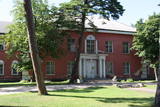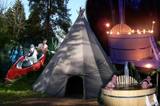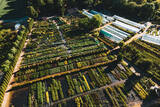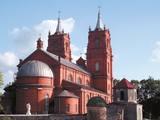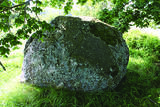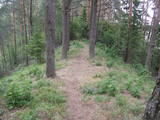| Нo | Название | Описание |
|---|---|---|
|
Atpūtas vietā ir apskatāmas 370 no koka veidotas skulptūras. Ir izveidoti 5 labirinti- 630 m garš pikants labirints ar “pipariņu” tikai pieaugušajiem, tulpju meditatīvais labirints, “Šausmu labirints”mežā, bērniem- 25 m garš labirints ar maldīšanos upenēs “Tracis”, zaru labirints “Dižputna ligzda”. 60 dažādas lielformāta brīvdabas spēles un atrakcijas. Dabas taka “Putnu iela”, kurā apskatāmi Latvijas dobumperētāju putnu būrīši. |
||
|
This is certainly the thickest White Willow (Salix alba) in Latvia and perhaps the thickest one in the Baltic States. Many of its mighty branches are resting on the ground, and the enormous monolithic trunk has been split. There’s a small information stand alongside the tree. A pathway which starts at the Raganu cliffs can be taken to the tree.
|
||
|
Хозяин свое пчеловодческое хозяйство основал на красивом берегу озера, на месте старинного жилья, расположив пчелиные улья в двух местах – на приозерном холме и на красивом лесном лугу, который хозяин преобразовал сам. Рядом с пасекой находится красивый яблоневый сад, в котором осенью хозяин рад видеть помощников. С 1996 года хозяин понемногу обновлял и ухаживал за этим хозяйстом, в котором уже красивое широкое озеро, домик у озера, клеть с отремонтированным помещением над клетью и балконом, пасека и яблоневый сад. |
||
|
Здание бывшего военного госпиталя окружено парком, с севера – Вентспилским приморским парком. Здание сохранило некоторые небольшие архитектурные формы.
|
||
|
Маршрут начинается и заканчивается в Каунасе, втором по величине городе Литвы, который был столицей страны с 1920 по 1939 год. В хозяйстве Тадаса Иванаускаса у парка Обелинес вы можете увидеть коллекцию из 300 сортов и видов растений, а в яблоневом саду растет одно из старейших деревьев - гинкго двулопастный. В Каунасе вы сможете увидеть самую старую - почти 360-летнюю - яблоню, высотой 8 метров, 285 см в обхвате на высоте 1,3 метра. В Каунасском ботаническом саду университета Витаутаса Великого обустроена самая большая оранжерея в Литве, а также находится коллекция растений старинных цветочных видов. Литовский институт садоводства проводит как научную, так и экспериментальную / производственную деятельность, здесь можно приобрести саженцы, а также сезонные фрукты и овощи. Хозяйство Гарси Тила предлагает приготовленные на домашней кухне «счастливые блюда», а также прогулку по своему 100-летнем саду с лекарственными травами. В ландшафтном и скульптурном парке Бурбишского поместья проходит ежегодный фестиваль тюльпанов. В музее деревни Клебонишкяй можно осмотреть дома, характерные для региона Аукштайтии. Ботанический сад Шяуляйского университета отображает растительное наследие, которое организовано в соответствии с довоенными, межвоенными и послевоенными периодами. В сельском музее Людвики и Станиславы Диджилю собраны традиционные литовские сорта яблонь, цветов и растений. Мемориальный музей А. Баранаускаса и А. Виенолиса-Жукаускаса в Аникщяйской области знакомит с культурой, литературой, историей, аграрной культурой и технической историей. Традиционный литовский цветочный сад можно увидеть в Мемориальном музее Броне Буйвидайте. В Аникщяе можно прогуляться по тропе среди верхушек деревьев и по парку лабиринтов, а также отправиться в поездку по Аукштайтской узкоколейкой железной дороге. В Ботаническом саду Траупе вы найдете коллекцию многолетних цветов, каменный сад, часы из цветов и декоративный бассейн с водными растениями. Интерьер поместья Тауенов украшен портретами семьи Радзивиллов, скульптурами, охотничьими трофеями и антикварным оружием. В Укмергском районе посетите Узугирскую усадьбу президента Антанаса Сметонаса, где в его честь оборудован мемориальный музей. В конце путешествия осмотрите Литовский музей под открытым небом, один из крупнейших (194 га) и богатейших (91 420 экспонатов) этнографических музеев под открытым небом в Европе. |
||
|
Целью туристического центра Лахемаа является пропаганда природосберегающего образа жизни и умения жить в природе-сажаются деревья и развешиваются домики для птиц. Для интересующихся - походы на каноэ по Лахемааскому национальному парку, походы по болоту и стрельбу из лука и арбалета. Приятно провести время можно в каминном зале и сауне с гидромассажной ванной. |
||
|
Один из самых богатых и живописных питомников в Латвии. Он содержит около 1000 различных видов, сортов и форм растений. Экскурсия, приобретение лиственных и хвойных деревьев, декоративных кустарников, саженцев для живых изгородей, виноградных лоз, вьющихся растений, великолепных привитых деревьев и контейнерных саженцев кустов. Великолепный дендрарий (ознакомительный сад), консультации. |
||
|
Семейное предприятие предлагает высококачественные продукты традиционного пчеловодства из Национального парка Гауи (~ 150 семей) - мед, пыльца, пчелиный хлеб, воск и прополис и создает новые, небывалые еще на рынке продукты, которые удовлетворяют необычные, но здоровые пожелания клиентов. Экскурсия, покупка меда. |
||
|
Наутренский (Роговский) Римско-католический костёл
Непорочного зачатия Девы Марии построен из кирпича в
романском стиле и c двумя высокими башнями (1901 – 1914 гг.)
вместо старого костёла. В 1939 году был приобретен орган –
памятник искусства.
|
||
|
Первая церковь здесь появилась в начале 18 столетия. Затем - вторая и третья (1847 - 1848), наблюдаемая сейчас. Храм пострадал и во время Первой мировой войны, и в советское время, когда с 1969 по 1993 год здесь размещался цех по производству ватина. Сейчас здание (в девяностых годах - в очень печальном состоянии) понемногу возвращает свой облик. Следует добавить, что в период с 1826 по 1856 год в храме пономарем и органистом работал латышский поэт и переводчик Ансис Ливенталс (1803 – 1878 гг.). Его могила с памятником находится рядом с церковью. Там же находятся кладбища русских и немецких солдат, павших во время Первой мировой войны, и надгробный памятник священника и писателя Якоба Флорентина Лундберга (1782 - 1857). |
||
|
Находится около Улмалес, примерно в 300 м от шоссе Лиепая - Вентспилс (есть указатели). Очень красивый и ярко выраженный камень с углублением, в верхней части которого продолблено углубление глубиной 15 см и диаметром до 61 см. Предположительно, что здесь (особенно в 16 - 18 вв.) было старинное культовое место. |
||
|
В хозяйстве выращивают крупный рогатый мясной скот и овощи. Интересующимся дают консультации, продают семена и овощи. |
||
|
Предлагают экскурсию по богатому и живописному питомнику, в котором насчитывается около 3000 видов, пород и форм растений. Широкий ассортимент водных растений, можно приобрести саженцы и получить консультацию по их выращиванию. |
||
|
Строительство замка в Сигулде было начато орденом Меченосцев в 1207 году, а в 1236 году его переоборудовали для нужд Ливонского ордена. Замок в Сигулде сильно пострадал в войнах второй половины 16 и началa 17 века. Во время Северной войны его сжигают и более не восстанавливают. На сегодняшний день для осмотра доступно здание конвента юго-западного корпуса замка и башня главных ворот, за которой находится внутренний форбург с эстрадой под открытым небом, открывающей великолепный вид на долину реки Гауя. Строительство Нового замка Сигулды, находящегося на юге (владелец - князь Кропоткин), проводилось в период с 1878 - 1881 годa. B 1923 - 1940 годы в здании располагался Дом писателя, а во время СССР - кардиологический санаторий. С 2003 года здесь находится Сигулдская краевая дума. В комплексе имения сохранилось деревянное жилое здание (середина 19 века), в котором находился дом семьи Кропоткина, амбар (конец 18 – начало 19 века), дом садовника (19 век) и каменная ограда (19 век). Если от Нового замка мы поедем в северо-восточном направлении, менее чем через 2 км мы подъедем к оврагу Вейупите (речка Ветров). Здесь находится неглубокая (3,6 м), но высокая (6,1 м) пещера Святого Петра и глубокий Совий овраг с Крауклюпите (речка Ворона). На месте соприкосновения двух оврагов возвышается городище Сатезеле (площадка 90 × 75 м), где в начале 13 века находился дубовый замок вождя земли ливов - Дабреля. Недалеко находится ущелье Воронов - боковая ложбина левого берега Вейупите со стенами из песчаника высотой 11 метров и пещера Ворона глубиной 5,2 метра. На месте соприкосновения оврага Вейупите и русла реки Гауя возвышается Райская гора (Художников) – очень живописный ландшафт, вдохновлявший художников еще с древних времен. В западной части Сигулды можно посетить Колесо обозрения (работает в летнее время) и канатную дорогу (трамвай) - единственное транспортное средство подобного типа в странах Балтии (построена в 1969 году). Несущий трос канатной дороги тянется без поддержек 1060 метров и соединяет берега долины реки Гауя между Сигулдой и Кримулдой на высоте около 40 м над рекой. В юго-западной части Сигулды можно посетить утес Бейте, пересеченный глубоким оврагом ручья. На западной стороне оврага находится Государев вид, который находится на высоте 67 метров над уровнем реки Гауя с великолепным видом на Кримулду и Турайдский замок. Смотровую площадку здесь обустроили в 1862 году, когда Сигулду посетил российский царь Александр II. На восточной стороне оврага расположен выполненный из дерева Трон государя. На месте, где правый берег русла реки Гауя пересекает множество глубоких оврагов небольших ручейков, расположился Турайдский музей-заповедник с имеющими большую ценность для всей Балтии памятниками, история которых тянется на 1000 лет назад. Среди них следует упомянуть Турайдское имение (21 здание), могила Турайдской Розы, Турайдская Лютеранская церковь (одна из старейших деревянных церквей Латвии (1750 год)) и Турайдский замок. На располагающейся рядом горе Дайн организуются различные тематические мероприятия. |
||
|
Большой чумной камень – с вырубленными письменами (немного еще про-
сматриваются), обращенными к будущим поколениям и повествующими о местном
пасторе того времени, который умер от чумы, и о создании пастората в Сикраге,
который в последствии был перенесен в Мазирбе. Чумной камень является и памят-
ником шести пасторам обширной окрестной общины. Все три камня повествуют о
Великой чуме 1710 года, а письмена на камнях вырублены во времена мазирбского
пастора Петерсона с 1711 по 1734 год.
|
||
|
Kuģīša piestātne atrodas Ostas ielas malā, kur tai piekļaujas Tirgus iela. „Hercogs Jēkabs” ekskursantus izvizina 45 minūšu garā braucienā (no maija – oktobrim) pa Ventas grīvu, piedāvājot aplūkot Ventspils ostas un vecpilsētas ainavas no citiem skatu punktiem. |
||
|
На 141 километре шоссе Риги - Екабпилс можно отдохнуть и покушать в мотеле «Сапнис». На первом этаже – кафе и зал для торжеств. |
||
|
«Айритес» находится на том месте, где первый главнокомандующий Латвийскими вооруженными силами полковник Оскарс Калпакс и другие латышские воины (в том числе три офицера) погибли 6-го марта 1919-го года в бою возле Айритес. В 1920-м году на пожертвованные средства в Айритес начали возводить памятник, который открыли 3-го сентября 1922-го года. В 1935-м году по инициативе объединения «Батальон полковника Балодиса» началось строительство здания, в котором планировалось разместить музей, посвященный борьбе батальона Калпака. Его открыли годом позже. В советское время памятный ансамбль был уничтожен, а в здании разместили почту и оборудовали квартиры. Во времена Атмоды (1988 – 1989) памятное место было восстановлено, а 11-го ноября 1990-го года заново был открыт музей О. Калпака. В 2007-м году во время ремонтных работ сгорел второй этаж здания. Музей и экспозицию восстановили в 2013-м году. Экспонаты рассказывают о жизненном пути и об участии О. Калпака в Борьбе за независимость Латвии и боях Первой мировой войны. Работники музея регулярно организуют мероприятия памяти О. Калпака и празднования дня Лачплесиса. |
||
|
Apmeklētājiem tiek piedāvāta ekskursija ar stāstiem par Limbažiem, kas kādā veidā saistīti ar sudrabu. Ekskursijas laikā iespējams apskatīt paraugdemonstrējumus lodēšanā. Sadarbībā ar juvelieriem, darbnīcā būs iespējas apgūt prasmes darbam ar misiņu un sudrabu, tiks piedāvātas arī meistarklases. Pēc iepriekšējas pieteikšanās grupām būs pieejamas arī O.Auzera lekcijas par sudraba ietekmi uz veselību. Ekspozīcija atvērta apmeklētājiem no trešdienas līdz svētdienai no pl.10:00-17:00, citā laikā grupām- pēc iepriekšēja pieteikuma. Ieejas maksa: |
||
|
This is another so-called hill left behind by the Ice Age – five kilometres long with a height of between 15 and 30 metres and with high hillocks and steep hillsides. Te most distinct part of the hill can be found between Lake Pinti and Lake Šeški. The pine forests on the hillocks are a habitat with many rare and protected species. A trail has been established to tour Grebļa Hill, as well as Āža Hill and Kausu Hill, but it is recommended that visitors travel the trail in the company of a guide. The biological diversity of the area is made clear if one knows, for instance, that more than 500 kinds of butterflies have been found in the restricted territory.
|
||




